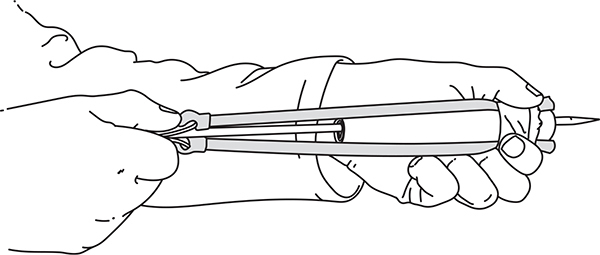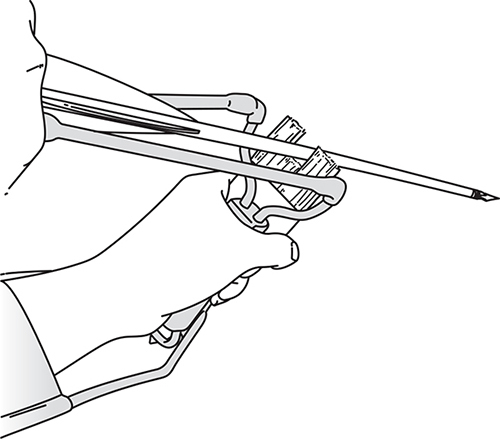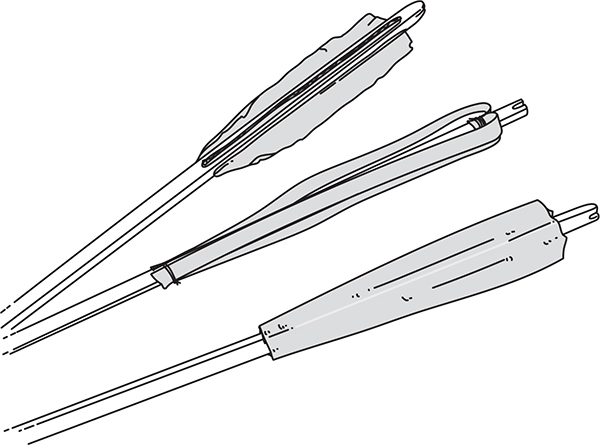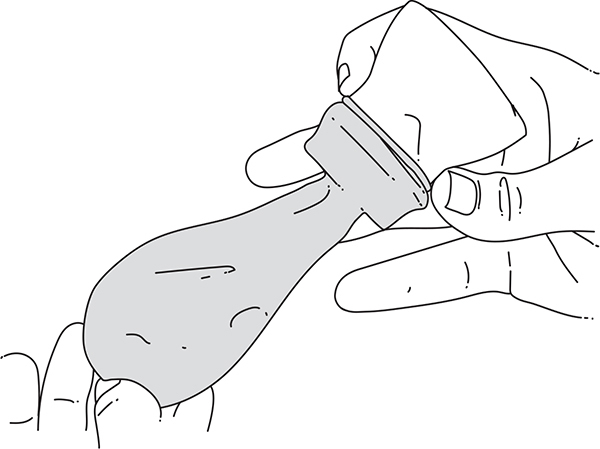
8" PIPE BOW
You can fashion an incredibly powerful bow from a short section of PVC pipe, surgical tubing, and a small square of leather. First, cut 2 10" sections of surgical tubing (or exercise bands). Lash one end of each tube through a hole in the left and right side of the leather patch. This will make a slingshot band set. Finally, wrap-lash or tape the other ends of the tubing along the lower sides of the pipe as shown in the picture. You can load an arrow or dart, draw (as shown), and fire it with incredible force. This makes a suitable low-profile hunting or self-defense bow for a survival scenario. You can also shorten the tubing on a bow of this style to launch much shorter dart arrows for smaller game and birds.

TWEEZERS GIG
Almost every woman I know has a pair of tweezers in her purse. Not only are they good for removing splinters, but you can also use them to catch a frog! Bullfrogs are an amazing survival food source in spring and summer months, but catching them can be quite a challenge. Traditionally, frogs are hunted with barb-pointed trident gigs. When paired with a flashlight to momentarily blind the frog, this is an extremely effective method. Lash a pair of tweezers to the end of a thin, strong stick to make a very effective two-pronged frog gig. Tweezers are sharp and pointed to begin with so no sharpening is necessary. Because tweezers don’t have barbs, you have to stab and hold the frog in place and reach down and grab it with your hand. It will slip off your tweezers gig if you try to pull it up from the pond or riverbank.
SLINGSHOT WHISKER BISCUIT
Any slingshot can quickly be converted into an arrow-shooting sling bow with one very simple addition—a paintbrush. Cut a 1⁄2"-wide depression from the bristles of a 2"-wide paintbrush to create a perfect whisker biscuit cradle for a full-sized hunting arrow. The cut notch in the paintbrush bristles will create an arrow rest, and the arrow fletching will slide through the bristles without hesitation. Pinch the arrow nock in the slingshot pouch, pull back, aim, and fire. Although the brush can easily be taped in place, a Velcro strap makes putting it on and taking it back off a breeze in the field. A hunter can switch from steel shot to hunting arrows in a matter of seconds without having to carry a roll of duct tape. This hack is from my friends Hank Gevedon and Dave Mead of Reptile Toolworks and online at Kentucky River Trading Company (www.kyrivertradingco.com).

DAVID’S SLING FROM YOUR SHOES
Your 2 shoestrings and 1 of your shoe tongues can make a sling powerful enough to bring down a giant (or small game for dinner). Cut your shoe tongue in an eye shape; about 4" long, tapered on each end and 2" wide in the middle. Punch a hole in the left and right side. Tie a 36" piece of shoelace to each side. Tie a loop using a bowline knot (www.willowhavenoutdoor.com/bowline-knot) on one end of one of the laces and an overhand knot (first knot when you tie your shoes) on the end of the other. Place the loop around the ring finger on your throwing hand and pinch the overhand knot between your thumb and index finger. Load the pouch with a smooth rock, sling above your head, and release the knot when you want to launch the projectile. This hunting tool can be very effective, but you’ll need a ton of practice to become accurate with it.
IMPROVISED ARROW FLETCHING
Almost any lightweight straight wooden shaft can be fashioned into an arrow for hunting. The ones shown have been split and shaped out of a board from a shipping pallet. After smoothing it and nocking it at the end with a saw, it’s time to add the fletching. The fletching is the feathers on the arrow that stabilize it and help it to fly straight. A fletching is critical to the accuracy of any improvised hunting arrow. I know of three outstanding fletching hacks. Cardboard, shown first, can be trimmed and glued into place as shown. Duct tape can also be applied as shown to make a great arrow fletching. Finally, almost any thin rope or ribbon can be tied on as shown to help stabilize an arrow. This hack is from my friends Hank Gevedon and Dave Mead of Reptile Toolworks and online at Kentucky River Trading Company (www.kyrivertradingco.com).

KEY TO EATING WILD GAME
You may not have nice store-bought, razor-sharp broadhead arrow tips in a survival scenario, but chances are you’ll have your house keys in your pocket. Believe it or not, the key to your house can also be your key to dinner. All that’s required is a regular run-of-the-mill metal file. The key can be shortened by 1⁄2" to reduce bulk and weight and the tip sharpened. Then, file the left and right sides to a razor edge. Lashing points can be filed around the edge of the base and then you can lash the key into the end of a wooden shaft to make a very effective metal-tipped hunting arrow. This hack is from my friends Hank Gevedon and Dave Mead of Reptile Toolworks and online at Kentucky River Trading Company (www.kyrivertradingco.com).

CARPET QUIVER
After you’ve made arrows using some of the hacks previously mentioned, you’ll now need a quiver to put them in. A water bottle, a scrap piece of carpet, and a roll of duct tape can make a very durable and functional quiver. Roll a water bottle (at the bottom) and a roll of duct tape (at the top) in a scrap piece of carpet or even an old welcome mat and wrap it with cord to hold everything together and to provide a shoulder sling. The roll of duct tape makes for a solid opening, and the water bottle (with the top cut off) makes a good puncture-proof bottom. This quiver is lightweight, easy to make, and will safely hold up to 10 arrows with no problem. This hack is from my friends Hank Gevedon and Dave Mead of Reptile Toolworks and online at Kentucky River Trading Company (www.kyrivertradingco.com).
BALLOON BOTTLE SLING
The most basic of dart or rock slings can be manufactured from a balloon and the neck of a trash plastic bottle. First, cut the neck off the bottle a few inches below the mouth. It should resemble a small funnel. Remove the cap and stretch the mouth of the balloon over the threaded bottle opening and wrap cordage around the balloon to hold it tightly over the grooved threads where the cap would twist. Place a dart or ball bearing through the large end of the bottle and pinch it between your index finger and thumb inside of the balloon. Hold the neck of the bottle with one hand and retract the projectile back as far as you can pull. When released, the elasticity of the balloon will fire the dart or ball bearing with enough force to kill small birds or distract a stalking man or beast.

TRAPPING HACKS
A BETTER MOUSETRAP
Although mice aren’t a choice wild-game meat, they can make good bait (live or dead) for a variety of larger game. You can make a very effective mousetrap from a 5-gallon bucket, a straight rod (either metal or wood), a water bottle or wheel, and some peanut butter (or other bait). Thread the wheel or water bottle over the straight rod so that it freely rotates with just a touch. Drill a hole on each side of the bucket with your knife so that the rod and spinning wheel/bottle is suspended in the center. Smear some peanut butter on the wheel/bottle and place a stick or board ramp to the edge of the bucket. When a mouse climbs up the ramp and jumps to eat the peanut butter the wheel/bottle will spin and dump the mouse into the bucket, where he will remain until you come back to retrieve him.